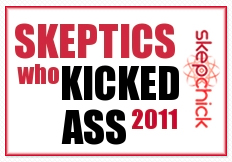I know I bang on about the TGA a lot, but today I received another reason to be eternally frustrated with the Aussie drug regulator.
—–
UPDATE: I was informed last night that the TGA has listed 13 dodgy devices on the ARTG in the past week. Seven are holographic devices, five are ‘energy patches’ and another is a TENS device. Amongst the “energy patches” are Lifewave, (yes those make-shit-up, nanotechnology homeopathic pieces of gauze) and holographic energy bracelets, (see Power Balance) called CieAura.
Regular readers would know by now that the process of getting a product listed on the ARTG is based on an honesty system where sponsors type in their product, select the ingredients from a pre-approved list, pay a fee (< $1000) and bing! Get an official looking L number for their product and a listing on the official government list of medical devices. I can’t say this often enough (and perhaps I should, given that I’m probably tipping sponsors off to ways around the TGA) but you don’t need to provide evidence up front. You just have to say you possess it.
I’ve blogged about this before.
That CieAura would make it onto the ARTG is just embarrassing given that they’re just a copy of PowerBalance who were chased out of Australia earlier this year by the ACCC (the TGA did play a role). And Lifewave? You only need to Google them to find links to scam websites and other dubious activities. Plus, they are homeopathic (so there’s nothing in them) and they are non-transdermal (so they don’t transfer anything into your system) so what exactly do they do then? Precisely.
Fortunately, there has been some good news this morning about this debacle. I’ve been informed that The Lifewave patches have been cancelled from the ARTG and the CieAura holographic bracelets are under investigation. I’ll keep you posted. In the meantime let’s continue to play whack-a-mole with the TGA, mischievous sponsors and the TGA. Cause until the legislation is changed, this process will continue unabated.
——-
An article from Australian Doctor described how a complaint against the makers of Nurofen – an ibuprofen based pain killer – were directed to stop claiming their product could “go to the site of pain”.
According to the article:
Reckitt Benckiser Australia Pty Ltd was ordered by the TGA’s complaints resolution panel to withdraw a television advertisement for Nurofen that claimed the product “targeted relief from pain” and “goes straight to the source of pain”.
However in a statement, Reckitt Benckiser said it did not agree with a number of the sanctions imposed by the TGA panel and therefore,
Nurofen advises that consumers will continue to see the familiar branding of the Nurofen target and messages of Nurofen working at the site of pain. This branding includes TGA approved claims on packs that Nurofen provides targeted relief from pain.
Sigh.
Of course Reckitt Benckiser are by no means the first company to essentially flip the bird and say “get stuffed we’ll do what we want” to the TGA. Indeed, today’s statement follows a damning audit of the TGA’s management of complementary and alternative therapies released recently, which essentially described the TGA as having no teeth to enforce rulings against companies who do the wrong thing. Mick Vagg has covered some of the details here.
The audit came after a review of a random sample of listed products – “listed” meaning supplements, vitamins, (some) homeopathic preparations and other products classified as “low risk” including 31 types of ear candles, which found over ninety percent of products breached TGA guidelines. This review was from 2009/2010 and the one 5 years prior to this found over seventy five percent of products breached guidelines.
Out of the 31 products which were selected for the 2009/10 review, only 3 were found to fully comply (I’ve blogged about this previously here). Of the rest, 22 were found to have manufacturing and/or quality issues, 20 had labelling issues such as non-compliance with labelling requirements and/or breaches which may mislead consumers, 12 included incomplete and/or inappropriate information, and 14 did not have adequate evidence to substantiate claims made about the medicines.
Let’s go over that again.
• 22 were found to have manufacturing and/or quality issues
• 20 medicines had labelling issues or breaches which may mislead consumers
• 14 did not have adequate evidence to substantiate claims made about the medicines
When it comes to consumer protection this is a pretty poor report for the TGA.
As a result of these failures, a significant number of products were removed from the Australian Register of Therapeutic Goods (ARTG).
It’s worth noting however that Nurofen is a registered drug, not a listed one (for the difference see my post here) so stricter rules apply when it comes to regulation of what’s in it and whether it works. With AUST L (listed) drugs, for example, companies or “sponsors” are not required to present evidence of safety and efficacy before they are rubber-stamped for sale by the government. However AUST R (registered) drugs – of which Nurofen is one – are.
Indeed AUST L drugs are considered low risk by the TGA, so have a soft-touch system of registration. To apply for an official number you go online, select from a list of pre-approved ingredients, describe what your product does, state you have evidence for your claims in your possession (but no need to produce it!) pay a fee and voila! Bob’s your uncle.
The fact that most consumers don’t know this was the basis for the recent call to label CAM in Australia with the disclaimer “This product has not been tested”. You can imagine how this went down with the industry.
However, advertising rules for L and R drugs are essentially the same – basically you can’t make claims which you can’t substantiate and if you do, the TGA can order you to remove them. Whether this be from a website – as has happened several times now with Homeopathy Plus! – or a television commercial, as is the case for Nurofen.
Once a complaint about a product is received (and the TGA relies on consumers to make complaints as they are not pro-actively seeking products which breach guidelines), the TGA will preside over it and if it’s upheld, direct the company to remove the offending material and/or publish a disclaimer. But, as has been known for some time and was also highlighted in the recent audit and on Lateline, approximately thirty percent of companies ignore these sanctions. And they can, because the TGA has never in its history enforced them. Ever.
From the audit:
Due to the very low financial penalties currently available (a maximum of $6,600 for individuals and $33,000 for corporations) for advertising offences in the Act and other investigative priorities for the TGA, it is not cost-effective for the TGA to initiate a formal investigation of an advertising breach with a view to preparing a brief of evidence for consideration of prosecution by the Director of Prosecution.
It has never been cost-effective for the TGA to initiate a formal investigation of an advertising breach with a view to preparing a brief of evidence.
In other words, the cost of prosecuting a company outweighs the fine, so it’s not worth it and it’s never been done. This of course makes the TGA the laughing stock of drug manufacturers. If you read between the lines of the Nurofen press release you can see it loud and clear:
Nurofen advises that consumers will continue to see the familiar branding of the Nurofen target and messages of Nurofen working at the site of pain…
Well of course they will. I mean $33,000 is a pittance for a large Pharma company anyway. It’s laughable to think this would be a deterrent to making some claims that might not be “quite right” but sound pretty good in marketing terms.
Homeopathy Plus! also declined to comply for similar reasons, saying they didn’t agree with the TGA’s findings that homeopathic immunisation is ineffective against polio, meningococcal, cholera, whooping cough and other serious diseases. They’ve since gone onto claim homeopathy can cure breast cancer, treat meningococcal disease and radiation poisoning. Jumped. The. Shark.
To go back to the TGA’s findings about Reckitt Benckiser, the complaints resolution panel found that;
reasonable consumers … would conclude that the active components of the product travelled specifically to areas of the body affected by pain — in this instance, the part of the head affected by a headache
Which I think is a fair call. But this is not how pain killers work. To say they are “targeted” is just nonsense.
Yet, this is not the first time Nurofen have been called out for shonky advertising. Indeed last year they were honoured with a 2010 Choice Shonky Award for a very similar thing;
From the Choice website;
Nurofen has … a range of caplets for migraine, back, tension headache and period pain. Yet a closer look at the ingredients shows they’re identical from product to product. So does the back pain version somehow magically go straight to your back – and only your back – as soon as you’ve swallowed it? Could you, say, choose to treat only your back pain while keeping your headache? The answers are no, no and definitely no.
As long as the TGA has no teeth to enforce dodgy claims and advertising breaches I expect we’ll see this type of behaviour continue. And even if they were to fine companies for breaches, 33,000 or 6,600 bucks is a pittance to most drug companies – whether CAM or science-based. There seems little deterrent to stop when there’s money to be made and no-one’s gonna stop you anyway.
In my opinion this is about consumer protection and if the TGA fails to do that, then I wonder what good they’re doing at all.
Browse Timeline
- « Anti-vax chiropractor is okay ’cause it’s just his opinion
- » Pharmacy Guild & Blackmores – do you want fries with your prescription?





